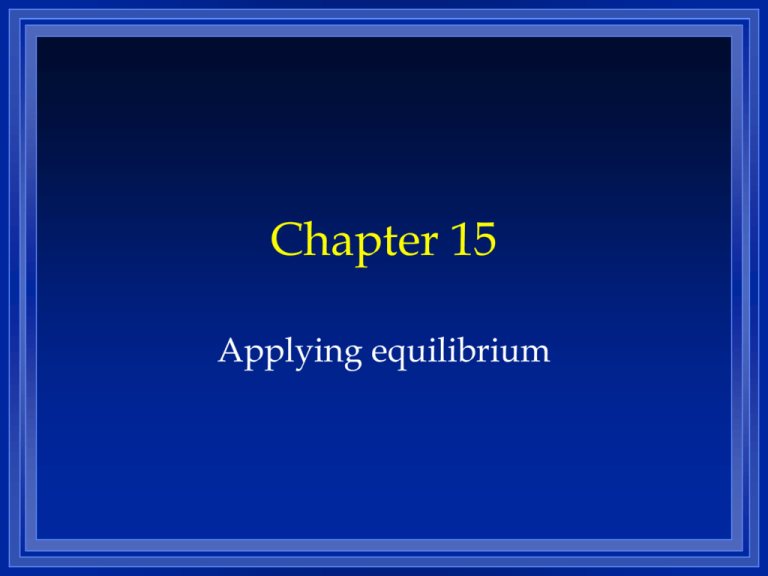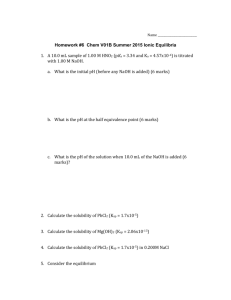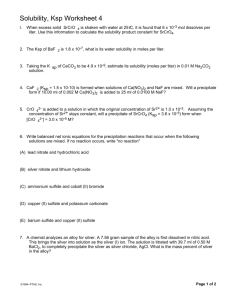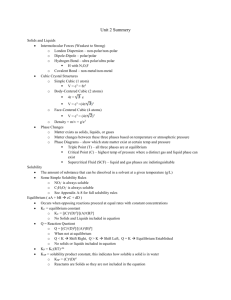AP Ch 15 apchapt15r
advertisement

Chapter 15 Applying equilibrium 15.1 The Common Ion Effect When the salt with the anion of a weak acid is added to that acid, it reverses the dissociation of the acid. NaF(s) Na+(aq) + F-(aq) adding NaCl( aq ) shifts equilibrium position Lowers the percent dissociation of the acid. The same principle applies to salts with the cation of a weak base. The calculations are the same as last chapter. Calculate [H+] and % dissociation of HF in a solution containing 1.0 M HF (Ka=7.2x10-4) and 1.0 M NaF Ex.15.1 15.2 Buffered Solutions A solution that resists change in its pH when either H+ or OH- are added. Either a weak acid and its salt or a weak base and its salt. We can make a buffer of any pH by varying the concentrations of these solutions. Same calculations as before.This is not a new type of problem. Calculate the pH of a solution that is 0.50 M HAc and 0.50 M NaAc (Ka = 1.8 x 10-5) Ex.15.2 Practice A buffer is made by dissolving NH4Cl and NH3 in water. Write equations to show how this buffer neutralizes added H+ and OH-. #22 Calculate the pH of each of the following solutions. #24 A) 0.100 M HONH2 (Kb = 1.1 x 10-8) B) 0.100 M HONH3Cl C) Pure H2O D) A mixture of 0.100 M HONH2 and 0.100 M HONH3Cl Compare % dissociation of A with D #26 Adding a strong acid or base Do the stoichiometry first. A strong base will grab protons from the weak acid reducing [HA]0 A strong acid will add its proton to the anion of the salt reducing [A-]0 Then do the equilibrium problem. What is the pH of 1.0 L of a solution(0.50M HC2H3O2 & 0.50M NaC2H3O2 ) when 0.010 mol of solid NaOH is added? Ex.15.3 What is the pH when .010 mol of solid NaOH is added to plain water? Ex.15.3 General equation to HH Ka = [H+] [A-] [HA] so [H+] = Ka [HA] [A-] The [H+] depends on the ratio [HA]/[A-] taking the negative log of both sides pH = -log(Ka [HA]/[A-]) pH = -log(Ka)-log([HA]/[A-]) pH = pKa + log([A-]/[HA]) This is called the HendersonHasselbach equation pH = pKa + log([A-]/[HA]) pH = pKa + log(base/acid) Calculate the pH of the following mixtures: 0.75 M lactic acid (HC3H5O3) and 0.25 M sodium lactate (Ka = 1.4 x 10-4) Ex.15.4 0.25 M NH3 and 0.40 M NH4Cl (Kb = 1.8 x 10-5) Ex.15.5 Prove they’re buffers 0.75 M lactic acid (HC3H5O3) and 0.25 M sodium lactate (Ka = 1.4 x 10-4) 0.25 M NH3 and 0.40 M NH4Cl (Kb = 1.8 x 10-5) What would the pH be if 0.10 mol of HCl is added to 1.0 L of both of the preceding solutions. Ex.15.6 What would the pH be if 0.050 mol of solid NaOH is added to each of the proceeding. Buffer Summary Buffers contain relatively large amounts of weak acid and corresponding base. Added H+ reacts to completion with the weak base. Added OH- reacts to completion with the weak acid. (YDVD) The pH is determined by the ratio of the concentrations of the weak acid and weak base. QuickTime™ and a Cinepak Codec by Radius decompressor are needed to see this picture. 15.3 Buffer Capacity Represents the amount of H+ or OH- the buffer can absorb without a significant change in pH. The pH of a buffered solution is determined by the ratio [A-]/[HA]. As long as this doesn’t change much the pH won’t change much. The more concentrated these two are the more H+ and OH- the solution will be able to absorb. Larger concentrations bigger buffer capacity. Buffer Capacity Calculate the change in pH that occurs when 0.010 mol of HCl(g) is added to 1.0L of each of the following: Ex.15.7 5.00 M HAc and 5.00 M NaAc 0.050 M HAc and 0.050 M NaAc Ka= 1.8x10-5 Buffer Capacity The best buffers have a ratio [A-]/[HA] =1 This is most resistant to change. True when [A-] = [HA] Make pH = pKa (since log 1 = 0) Practice A chemist needs a solution buffered at a pH of 4.30 and can choose from the following acids (and their sodium salts): Ex.15.8 Chloroacetic acid (Ka = 1.35 x 10-3) Propanioc acid (Ka = 1.3 x 10-5) Benzoic acid (Ka = 6.4 x 10-5) Hypochlorous acid (Ka = 3.5 x 10-8) Practice A solution is composed of 0.60 M HF and 1.00 M KF. #36 Ka=7.2 x10-4 – Calculate the pH after 0.10 mol of NaOH is added to 1.00L of this solution. – Calculate the pH after 0.20 mol of HCl is added to 1.00L of this solution. Practice A buffered solution is made by adding 50.0 g NH4Cl to 1.00L of a 0.75 M solution of NH3. Calculate the pH of the final solution. #38 Kb =1.8 x 10-5 An aqueous solution contains dissolved C6H5NH3Cl and C6H5NH2. The conc. of C6H5NH2 is 0.50 M and pH 4.20. Kb =3.8 x 10-10 Calculate the conc. of C6H5NH3+ in this buffer solution. #40 Calculate the pH after 4.0 g of NaOH(s) is added to 1.0 L of this solution 15.4 Titrations Millimole (mmol) = 1/1000 mol Molarity = mmol/mL = mol/L Makes calculations easier because we will rarely add Liters of solution. Adding a solution of known concentration until the substance being tested is consumed. This is called the equivalence point. Graph of pH vs. mL is a titration curve. Strong Acid with Strong Base Do the stoichiometry. There is no equilibrium . They both dissociate completely. The titration of 50.0 mL of 0.200 M HNO3 with 200 ml of 0.100 M NaOH (Case Study) Analyze the pH 0 ml, 10 ml, 20 ml, 100 ml, 150 ml, 200 ml *Look at GA SASB Weak acid with Strong base There is an equilibrium. Do stoichiometry. The reaction is assumed to run to completion - then determine remaining species. Then do equilibrium. Determine the position of weak acid equilibrium and calculate pH. Titrate 50.0 mL of 0.10 M Hac (Ka = 1.8 x 10-5) with 0.10 M NaOH (Case Study) 0 ml, 10 ml, 25 ml, 40 ml, 50 ml, 60 ml, 75 ml *Look at GA WASB The pH at equivalence point of a titration of a weak acid with a strong base is always greater than 7. Why? Weak acid/Stong base titration curve.Where are the following? •(a) Stoichiometric (equivalence) point. •(b)Region of maximum buffering. •c. pH=pKa •(d)pH depends only on [HA] •(e)pH depends only on [A-] •(f) pH depends only on the amount of excess base added. Weak Base/Strong Acid 100.0 ml of 0.100 M H2NNH2 (Kb = 3.0 x 10-6) was titrated by 0.200 M HNO3. Calculate the pH of the resulting solution after the following volumes of HNO3 have been added: 0.0 ml, 20.0 ml, 25.0 ml, 40.0 ml, 50.0 ml, 100.0 ml #56 Titrate 100.0 mL of 0.050 M NH3 with 0.10 M HCl. (Kb = 1.8 x 10-5) case study What is the pH at the following points: 0 ml, at the half way point, at equivalence point, beyond equivalence point. (60ml) Weak Base/Strong Acid In the titration of 50.0 ml of 1.0 M CH3NH2 (Kb = 4.4 x 10-4), with 0.50 M HCl, calculate the pH under the following conditions. #62 A) after 50.0 ml of 0.50 M has been added B) at the equivalence point Titration Curves Strong acid with strong Base Equivalence at pH 7 pH 7 mL of Base added Weak acid with strong Base Equivalence at pH >7 pH >7 mL of Base added Strong base with strong acid Equivalence at pH 7 pH 7 mL of Base added Weak base with strong acid Equivalence at pH <7 pH <7 mL of Base added Summary Strong acid and base - just stoichiometry. Determine Ka, use for 0 mL base Weak acid before equivalence point –Stoichiometry first –Then Henderson-Hasselbach Weak acid at equivalence point Kb Weak base after equivalence - leftover strong base. Summary Determine Ka, use for 0 mL acid. Weak base before equivalence point. –Stoichiometry first –Then Henderson-Hasselbach Weak base at equivalence point Ka. Weak base after equivalence - leftover strong acid. 15.5 Indicators Weak acids that change color when they become bases. Weak acid written HIn Weak base HIn H+ + Inclear red Equilibrium is controlled by pH End point - when the indicator changes color. Indicators Since it is an equilibrium the color change is gradual. It is noticeable when the ratio of [In-]/[HI] or [HI]/[In-] is 1/10 Since the Indicator is a weak acid, it has a Ka. The pH the indicator changes at is: pH=pKa +log([In ]/[HI]) = pKa +log(1/10) pH=pKa - 1 on the way up Indicators pH=pKa + log([HI]/[In-]) = pKa + log(10) pH=pKa+1 on the way down Choose the indicator with a pKa 1 less than the pH at equivalence point if you are titrating with base. Choose the indicator with a pKa 1 greater than the pH at equivalence point if you are titrating with acid. Practice Two drops of indicator HIn (Ka=1.0 x 10-9), where HIn is yellow and In- is blue, are placed in 100.0 ml of 0.10 M HCl. # 65 What color is the solution initially? The solution is titrated with 0.10 M NaOH. At what pH will the color change occur? Practice Using Fig. 15.8 (next page), which indicators could be used for the following titrations with pH at equivalence point given. #68,70 7.00 4.82 8.79 3.27 15.6 Solubility Equilibria Will it all dissolve, and if not, how much? All dissolving is an equilibrium. If there is not much solid it will all dissolve. As more solid is added the solution will become saturated. Solid dissolved The solid will precipitate as fast as it dissolves . (BDVD) Supersaturated, A-16,A-17 Solubility Product For solids dissolving to form aqueous solutions. Bi2S3(s) 2Bi3+(aq) + 3S2-(aq) Ksp = solubility product constant, therefore: Ksp = [Bi3+]2[S2-]3 Write a balanced equation and the solubility expression for the following: Ag2CO3, Ce(IO3)3, BaF2 Watch out Solubility is not the same as solubility product. Solubility product is an equilibrium constant. It doesn’t change except with temperature. Solubility is an equilibrium position for how much can dissolve. A common ion can change this. Calculating Ksp Find the Ksp of the following: The solubility of copper(I) bromide is 2.0 x 10-4 mol/L Ex.15.12 The solubility of Bi2S3 is 1.0 x 10-15 mol/L Ex.15.13 Vizzini: You fell victim to one of the classic blunders! The first is never get involved in a land war in Asia. The second, only slightly less well known, is this: never go up against a Sicilian when death is on the line! Ha ha ha ha ha ha -Richardson: The third: always pay attention to mole ratios when dealing with concentration. Calculating Ksp The concentration of Ag+ in a solution saturated with Ag2C2O4(s) is 2.2 x 10-4 M. Calculate the Ksp for Ag2C2O4. #78 Calculating Solubility The solubility is determined by equilibrium. Its an equilibrium problem. Calculate the solubility of Cu(IO3)2, with a Ksp of 1.4 x 10-7. Ex.15.14 Calculate the solubility of Sr3(PO4)2, with a Ksp of 1.0 x 10-31 #80c Relative Solubilities Ksp will only allow us to compare the solubility of solids that fall apart into the same number of ions. The bigger the Ksp of those the more soluble. AgI Ksp = 1.5 x 10-16 CuI Ksp = 5.0 x 10-12 CaSO4 Ksp = 6.1x10-5 If they fall apart into different number of pieces you have to do the math. Common Ion Effect If we try to dissolve the solid in a solution with either the cation or anion already present less will dissolve. Calculate the solubility of CaF2, with a Ksp of 4.0 x 10-11 in a solution of 0.025 M NaF. Ex.15.15 Calculate the solubility of SrSO4, with a Ksp of 3.2 x 10-7 in a solution of 0.010 M Na2SO4. Find M and g/L. pH and solubility OH- can be a common ion. More soluble in acid. For other anions if they come from a weak acid they are more soluble in a acidic solution than in water. CaC2O4 Ca+2 + C2O4-2 H+ + C2O4-2 HC2O4 Reduces C2O4-2 in acidic solution. (BDVD) Ag pH and solubility For which salt of each group will the solubility depend on pH? AgF, AgCl, AgBr Pb(OH)2, PbCl2 Sr(NO3)2, Sr(NO2)2 Ni(NO3)3, Ni(CN)2 15.7 Precipitation Ion Product, Q =[M+]a[Nm-]b If Q> Ksp a precipitate forms. If Q< Ksp No precipitate. If Q = Ksp equilibrium. -3 A solution of 750.0 mL of 4.00 x 10 M Ce(NO3)3 is added to 300.0 mL of 2.00 x 10-2 M KIO3. Will Ce(IO3)3 (Ksp = 1.9 x 10-10 M) precipitate from the mixed solutions? If so, what is the concentration of the ions? Ex.15.16 Precipitation Will a precipitate form when 100 ml of 4.0 x 10-4 M Mg(NO3)2 is added to 100 ml of 2.0 x 10-4 M NaOH? (Ksp=8.9 x 10-12) #92 A solution is prepared by mixing 150.0 ml of 1.00 x 10-2 M Mg(NO3)2 and 250.0 ml of 1.00 x 10-1 M NaF. Calculate the concentrations of Mg2+ and F- at equilibrium with solid MgF2 (Ksp = 6.4 x 10-9) Ex. 15.17 #96 if time Selective Precipitations Used to separate mixtures of metal ions in solutions. Add anions that will only precipitate certain metals at a time. Used to purify mixtures. Often use H2S because in acidic solution Hg+2, Cd+2, Bi+3, Cu+2, Sn+4 will precipitate. Selective Precipitation In basic solutions, the H+is removed from H2S making more S-2. More soluble sulfides will precipitate. Co+2, Zn+2, Mn+2, Ni+2, Fe+2, Cr(OH)3, Al(OH)3 Selective precipitation Follow the steps first with insoluble chlorides (Ag, Pb, Ba). Then sulfides in Acid. Then sulfides in base. Then insoluble carbonate (Ca, Ba, Mg) Alkali metals and NH4+ remain in solution. Selective precipitation A solution contains 1.0 x 10-4 M Cu+ and 2.0 x 10-3 M Pb2+. If a source of I- is gradually added to this solution, will PbI2 (Ksp= 1.4 x 10-8) or CuI (Ksp= 5.3 x 10-12) precipitate first? Specify the concentration of I- necessary to begin precipitation of each salt. Ex. 15.18 Complex ion Equilibria A charged ion surrounded by ligands. Ligands are Lewis bases using their lone pair to stabilize the charged metal ions. Common ligands are NH3, H2O, Cl-, CN Coordination number is the number of attached ligands. Most common are 4 and 6. (If guessing, 2 times the charge on the cation). Cu(NH3)4+2 has a coordination # of 4








